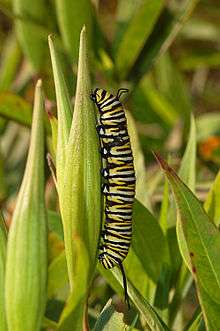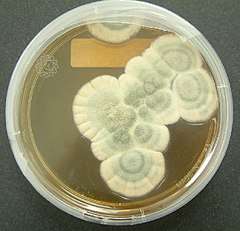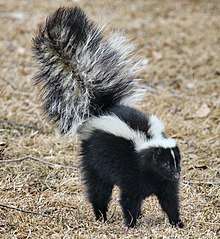Chemical defense

Chemical defense is a life history strategy employed by many organisms to avoid consumption by producing toxic or repellent metabolites.[1] The production of defensive chemicals occurs in plants, fungi, and bacteria, as well as invertebrate and vertebrate animals.[2][3] The class of chemicals produced by organisms that are considered defensive may be considered in a strict sense to only apply to those aiding an organism in escaping herbivory or predation.[1] However, the distinction between types of chemical interaction is subjective and defensive chemicals may also be considered to protect against reduced fitness by pests, parasites, and competitors.[4][5][6] Many chemicals used for defensive purposes are secondary metabolites derived from primary metabolites which serve a physiological purpose in the organism.[1] Secondary metabolites produced by plants are consumed and sequestered by a variety of arthropods and, in turn, toxins found in some amphibians, snakes, and even birds can be traced back to arthropod prey.[7][8] There are a variety of special cases for considering mammalian antipredatory adaptations as chemical defenses as well.
Prokaryotes and fungi

Bacteria of the genera Chromobacterium, Janthinobacterium, and Pseudoalteromonas produce a toxic secondary metabolite, violacein, to deter protozoan predation. Violacein is released when bacteria are consumed, killing the protozoan. Another bacteria, Pseudomonas aeruginosa, aggregates into quorum sensing biofilms which may aid the coordinated release of toxins to protect against predation by protozoans. Flagellates were allowed to grow and were present in a biofilm of P. aeruginosa grown for three days, but no flagellates were detected after seven days. This suggests that concentrated and coordinated release of extracellular toxins by biofilms has a greater effect than unicellular excretions.[9] Bacterial growth is inhibited not only by bacterial toxins, but also by secondary metabolites produced by fungi as well.[3][6] The most well-known of these, first discovered and published by Alexander Fleming in 1929, described the antibacterial properties of a "mould juice" isolated from Penicillium notatum. He named the substance penicillin, and it became the world's first broad-spectrum antibiotic.[3][10] Many fungi are either pathogenic saprophytic, or live within plants without harming them as endophytes, and many of these have been documented to produce chemicals with antagonistic effects against a variety of organisms, including fungi, bacteria, and protozoa.[3] Studies of coprophilous fungi have found antifungal agents which reduce the fitness of competing fungi.[6] In addition, sclerotia of Aspergillus flavus contained a number of previously unknown aflavinines which were much more effective at reducing predation by the fungivorous beetle, Carpophilus hemipterus, than aflatoxins which A. flavus also produced and it has been hypothesized that ergot alkaloids, mycotoxins produced by Claviceps purpurea, may have evolved to discourage herbivory of the host plant.[6]
Plants
A wealth of literature exists on the defensive chemistry of secondary metabolites produced by terrestrial plants and their antagonistic effects on pests and pathogens, likely owing to the fact that human society depends upon large-scale agricultural production to sustain global commerce. Since the 1950s, over 200,000 secondary metabolites have been documented in plants.[11] These compounds serve a variety of physiological and allelochemical purposes, and provide a sufficient stock for the evolution of defensive chemicals. Examples of common secondary metabolites used as chemical defenses by plants include alkaloids, phenols, and terpenes.[12] Defensive chemicals used to avoid consumption may be broadly characterized as either toxins or substances reducing the digestive capacity of herbivores. Although toxins are defined in a broad sense as any substance produced by an organism that reduces the fitness of another, in more specific sense toxins are substances which directly affect and diminish the functioning of certain metabolic pathways.[13][14] Toxins are minor constituents (<2% dry weight), active in small concentrations, and more present in flowers and young leaves. On the other hand, indigestible compounds make up to 60% dry weight of tissue and are predominately found in mature, woody species.[14] Many alkaloids, pyrethrins, and phenols are toxins. Tannins are major inhibitors of digestion and are polyphenolic compounds with large molecular weights. Lignin and cellulose are important structural elements in plants and are also usually highly indigestible. Tannins are also toxic against pathogenic fungi at natural concentrations in a variety of woody tissues.[1] Not only useful as deterrents to pathogens or consumers, some of the chemicals produced by plants are effective in inhibiting competitors as well. Two separate shrub communities in the California chapparal were found to produce phenolic compounds and volatile terpenes which accumulated in soil and prevented various herbs from growing near the shrubs. Other plants were only observed to grow when fire removed shrubs, but herbs subsequently died off after shrubs returned.[5] Although the focus has been on broad-scale patterns in terrestrial plants, Paul and Fenical in 1986 demonstrated a variety of secondary metabolites in marine algae which prevented feeding or induced mortality in bacteria, fungi, echinoderms, fishes, and gastropods.[15] In nature, pests are a severe problem to plant communities as well, leading to the co-evolution of plant chemical defenses and herbivore metabolic strategies to detoxify their plant food.[16] A variety of invertebrates consume plants, but insects have received a majority of the attention. Insects are pervasive agricultural pests and sometimes occur in such high densities that they can strip fields of crops.[17]
Animals
Invertebrates

Many insects are distasteful to predators and excrete irritants or secrete poisonous compounds that cause illness or death when ingested. Secondary metabolites obtained from plant food may also be sequestered by insects and used in the production of their own toxins.[16][18] One of the more well-known examples of this is the monarch butterfly, which sequesters poison obtained from the miilkweed plant. Among the most successful insect orders employing this strategy are beetles (Coleoptera), grasshoppers (Orthoptera), and moths and butterflies (Lepidoptera).[19][20] Insects also biosynthesize unique toxins, and while sequestration of toxins from food sources is claimed to be the energetically favorable strategy, this has been contested.[16][21] Passion-vine associated butterflies in the tribe Heliconiini (sub-family Heliconiinae) either sequester or synthesize de novo defensive chemicals, but moths in the genus Zygaena (family Zygaenidae) have evolved the ability to either synthesize or sequester their defensive chemicals through convergence.[16] Some coleopterans sequester secondary metabolites to be used as defensive chemicals but most biosynthesize their own de novo. Anatomical structures have developed to store these substances, and some are circulated in the hemolyph and released associated with a behavior called reflex bleeding.[18]
Vertebrates

Vertebrates can also biosynthesize defensive chemicals or sequester them from plants or prey.[8][21] Sequestered compounds have been observed in frogs, natricine snakes, and two genera of birds, Pitohui and Ifrita.[8] It is suspected that some well-known compounds such as batrachotoxins from poison frogs in the family Dendrobatidae and tetrodotoxin produced by newts and pufferfish[22] are derived from invertebrate prey. Bufadienolides, defensive chemicals produced by toads, have been found in glands of natricine snakes used for defense.[8]
Mammals
Some mammals can emit foul smelling liquids from anal glands, such as the pangolin[23] and some members of family Mustellidae including skunks, weasels, and polecats.[24] Monotremes have venomous spurs used to avoid predation[25] and slow lorises (Primates: Nycticebus) produce venom which appears to be effective at deterring both predators and parasites.[26] It has also been demonstrated that physical contact with a slow loris (without being bitten) can cause a reaction in humans – acting as a contact poison.[27]
See also
References
- 1 2 3 4 Berenbaum, M. R. (1995). The chemistry of defense: theory and practice. Proceedings of the National Academy of Sciences, 92(1), 2–8. doi:10.1073/pnas.92.1.2. PMC 42807. PMID 7816816.
- ↑ B. Clucas, Defensive Chemicals, In Encyclopedia of Animal Behavior, edited by Michael D. Breed and Janice Moore, Academic Press, Oxford, 2010, Pages 481–486, ISBN 9780080453378, doi:10.1016/B978-0-08-045337-8.00293-X.
- 1 2 3 4 Keller, N. P., Turner, G., & Bennett, J. W. (2005). Fungal secondary metabolism—from biochemistry to genomics. Nature Reviews Microbiology, 3(12). doi:10.1038/nrmicro1286.
- ↑ Walters, D. (2011). Plant defense: warding off attack by pathogens, herbivores and parasitic plants. John Wiley & Sons.
- 1 2 Whittaker, R., & Feeny, P. (1971). Allelochemics: Chemical Interactions between Species. Science, 171(3973), 757–770. JSTOR 1730763.
- 1 2 3 4 Gloer, J. B. (1995). The chemistry of fungal antagonism and defense. Canadian Journal of Botany, 73(S1), 1265–1274. doi:10.1139/b95-387.
- ↑ Lasley, E. N. (1999). Having Their Toxins and Eating Them Too: Study of the natural sources of many animals' chemical defenses is providing new insights into nature's medicine chest. BioScience, 49(12), 945–950. doi:10.1525/bisi.1999.49.12.945.
- 1 2 3 4 Savitzky, A. H., Mori, A., Hutchinson, D. A., Saporito, R. A., Burghardt, G. M., Lillywhite, H. B., & Meinwald, J. (2012). Sequestered defensive toxins in tetrapod vertebrates: principles, patterns, and prospects for future studies. Chemoecology, 22(3), 141–158. doi:10.1007/s00049-012-0112-z.
- ↑ Matz, C., & Kjelleberg, S. (2005). Off the hook—how bacteria survive protozoan grazing. Trends in microbiology, 13(7), 302–307. doi:10.1016/j.tim.2005.05.009.
- ↑ Fleming, A. (1929). On the antibacterial action of cultures of a penicillium, with special reference to their use in the isolation of B. influenzae. British journal of experimental pathology, 10(3), 226. PMC 2048009.
- ↑ Hartmann, T. (2007). From waste products to ecochemicals: fifty years research of plant secondary metabolism. Phytochemistry, 68(22), 2831–2846. doi:10.1016/j.phytochem.2007.09.017.
- ↑ Levin, D. A. (1976). The chemical defenses of plants to pathogens and herbivores. Annual Review of Ecology and Systematics, 7(1), 121–159. doi:10.1146/annurev.es.07.110176.001005. JSTOR 2096863.
- ↑ Wittstock, U., & Gershenzon, J. (2002). Constitutive plant toxins and their role in defense against herbivores and pathogens. Current opinion in plant biology, 5(4), 300–307. doi:10.1016/S1369-5266(02)00264-9
- 1 2 Cates, R. G., & Rhoades, D. F. (1977). Patterns in the production of antiherbivore chemical defenses in plant communities. Biochemical Systematics and Ecology, 5(3), 185–193. doi:10.1016/0305-1978(77)90003-5.
- ↑ Paul, V. J., & Fenical, W. (1986). Chemical defense in tropical green algae, order Caulerpales. Marine Ecology Progress Series, 157–169. JSTOR 24824962.
- 1 2 3 4 Fürstenberg-Hägg, J., Zagrobelny, M., Jørgensen, K., Vogel, H., & Møller, B. L. (2014). Chemical Defense Balanced by Sequestration and De Novo. doi:10.1371/journal.pone.0108745.
- ↑ Lomer, C. J., Bateman, R. P., Johnson, D. L., Langewald, J., & Thomas, M. (2001). Biological control of locusts and grasshoppers. Annual Review of Entomology, 46(1), 667–702. doi:10.1146/annurev.ento.46.1.667.
- 1 2 Dettner, K. (1987). Chemosystematics and evolution of beetle chemical defenses. Annual Review of Entomology, 32(1), 17–48. doi:10.1146/annurev.en.32.010187.000313.
- ↑ Schmidt, J. O. (2008). Venoms and toxins in insects. In Encyclopedia of entomology (pp. 4076–4089). Springer Netherlands. https://link.springer.com/referenceworkentry/10.1007%2F978-1-4020-6359-6_3957
- ↑ Trigo, J. R. (2000). The chemistry of antipredator defense by secondary compounds in neotropical Lepidoptera: facts, perspectives and caveats. Journal of the Brazilian Chemical Society, 11(6), 551–561. doi:10.1590/S0103-50532000000600002
- 1 2 Mebs, D. (2001). Toxicity in animals. Trends in evolution?. Toxicon, 39(1), 87–96. doi:10.1016/S0041-0101(00)00155-0.
- ↑ FUHRMAN, FREDERICK A. (December 1986). "Tetrodotoxin, Tarichatoxin, and Chiriquitoxin: Historical Perspectives". Annals of the New York Academy of Sciences. 479 (1 Tetrodotoxin, ): 1–14. doi:10.1111/j.1749-6632.1986.tb15556.x. ISSN 0077-8923.
- ↑
- ↑ Andersen, K. K., & Bernstein, D. T. (1980). Sulfur compounds in mustelids. In Natural sulfur compounds (pp. 399–406). Springer, Boston, MA. https://link.springer.com/chapter/10.1007/978-1-4613-3045-5_35
- ↑ http://agro.icm.edu.pl/agro/element/bwmeta1.element.agro-article-849d2510-89dd-4de9-9c38-cb3094d38f3b/c/app51-001.pdf
- ↑ Nekaris, K. A. I., Moore, R. S., Rode, E. J., & Fry, B. G. (2013). Mad, bad and dangerous to know: the biochemistry, ecology and evolution of slow loris venom. Journal of Venomous Animals and Toxins including Tropical Diseases, 19(1), 21. doi:10.1186/1678-9199-19-21.
- ↑ Gardiner, Matthew; Ariana, Weldon; Gibson, Nancy; Poindexter, Stephanie; Nekaris, K.A.I. (2018). "Survey of practitioners handling slow lorises (Primates: Nycticebus): an assessment of the harmful effects of slow loris bites – Journal of Venom Research". jvenomres.co.uk. Retrieved 2018-04-21.